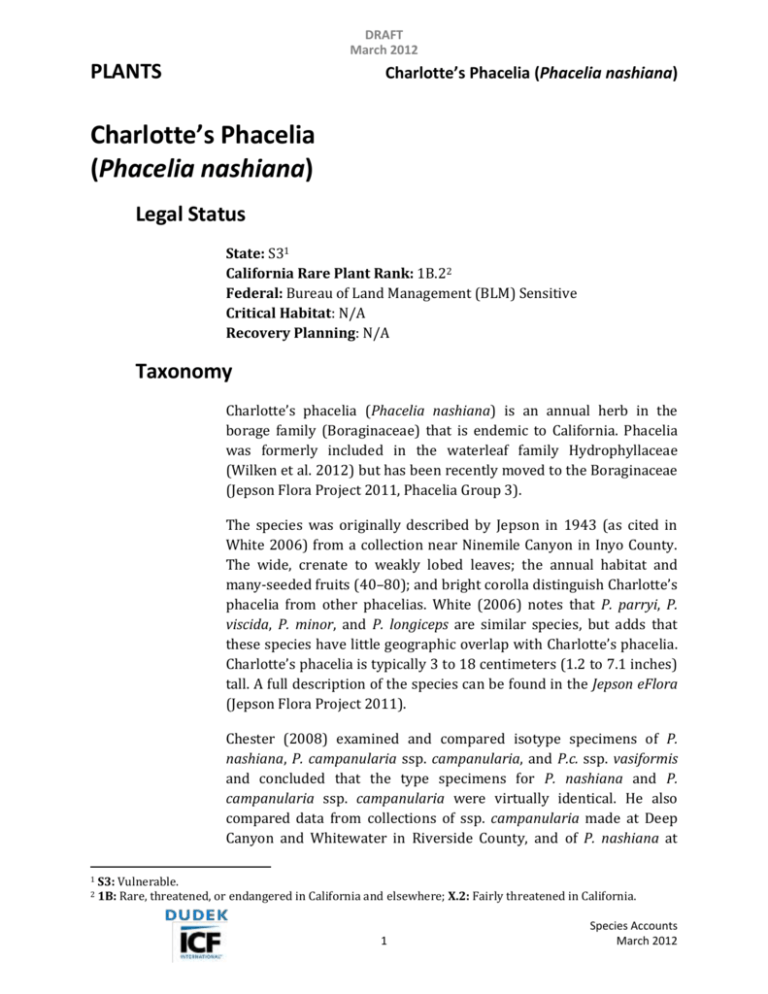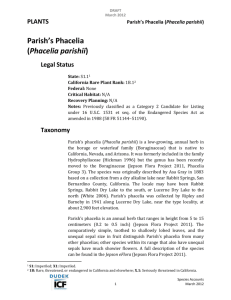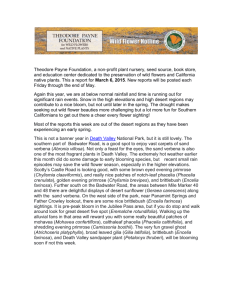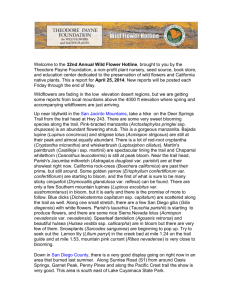Charlotte`s Phacelia
advertisement

DRAFT March 2012 PLANTS Charlotte’s Phacelia (Phacelia nashiana) Charlotte’s Phacelia (Phacelia nashiana) Legal Status State: S31 California Rare Plant Rank: 1B.22 Federal: Bureau of Land Management (BLM) Sensitive Critical Habitat: N/A Recovery Planning: N/A Taxonomy Charlotte’s phacelia (Phacelia nashiana) is an annual herb in the borage family (Boraginaceae) that is endemic to California. Phacelia was formerly included in the waterleaf family Hydrophyllaceae (Wilken et al. 2012) but has been recently moved to the Boraginaceae (Jepson Flora Project 2011, Phacelia Group 3). The species was originally described by Jepson in 1943 (as cited in White 2006) from a collection near Ninemile Canyon in Inyo County. The wide, crenate to weakly lobed leaves; the annual habitat and many-seeded fruits (40–80); and bright corolla distinguish Charlotte’s phacelia from other phacelias. White (2006) notes that P. parryi, P. viscida, P. minor, and P. longiceps are similar species, but adds that these species have little geographic overlap with Charlotte’s phacelia. Charlotte’s phacelia is typically 3 to 18 centimeters (1.2 to 7.1 inches) tall. A full description of the species can be found in the Jepson eFlora (Jepson Flora Project 2011). Chester (2008) examined and compared isotype specimens of P. nashiana, P. campanularia ssp. campanularia, and P.c. ssp. vasiformis and concluded that the type specimens for P. nashiana and P. campanularia ssp. campanularia were virtually identical. He also compared data from collections of ssp. campanularia made at Deep Canyon and Whitewater in Riverside County, and of P. nashiana at 1 2 S3: Vulnerable. 1B: Rare, threatened, or endangered in California and elsewhere; X.2: Fairly threatened in California. 1 Species Accounts March 2012 DRAFT March 2012 PLANTS Charlotte’s Phacelia (Phacelia nashiana) Borrego Palm Canyon in San Diego County, and concluded that the ssp. campanularia collections from Whitewater and Deep Canyon were most closely aligned with the taxon P. nashiana and that the population in Borrego Palm Canyon was P. nashiana and not P. campanularia ssp. campanularia. However, the Jepson Flora Project (2011) continues to recognize P. nashiana and P. campanularia ssp. campanularia as separate taxa. The Borrego Palm Canyon collections made by Chester, Madore, and Charters in 2005 were later annotated and confirmed as Charlotte’s phacelia by John Rebman in 2010 ( Consortium of California Herbaria 2011). Distribution General Based on the evident taxonomic confusion noted above, the distribution and extent of Charlotte’s phacelia is less clear, and occurrences of Charlotte’s phacelia could be more widespread than current records reflect. The records and distribution information in this report address the known locations of populations that have been previously identified as Charlotte’s phacelia, including the isolated population in San Diego County. Charlotte’s phacelia is an endemic species that occurs in the desertfacing foothills of the Sierra Nevada and the adjacent El Paso Mountains, in Tulare, Inyo, and Kern counties (CDFG 2012a). Although not included in the CNPS Inventory (CNPS 2011) or CNDDB (CDFG 2012a), Charlotte’s phacelia also occurs in Anza-Borrego State Park in San Diego County (Consortium of California Herbaria 2011). It ranges from about 1,600 to 7,200 feet in elevation (CDFG 2012a; Consortium of California Herbaria 2011). In addition to the Borrego population, species occurrences include the foothills above Fremont Valley, Red Rock Canyon State Park, the east-facing canyons above Indian Wells Valley, the southern and northeastern slopes and canyons of the El Paso Mountains, the El Paso Mountains, the Volcano Peak area within the China Lake Naval Air Weapons Center, and around Lake Isabella (BLM 2005; CDFG 2012a). 2 Species Accounts March 2012 DRAFT March 2012 PLANTS Charlotte’s Phacelia (Phacelia nashiana) The historical distribution of the species in California included locations near Red Rock Canyon, Indian Wells, along the Pacific Coast Trail and the eastern slopes of the Sierra Nevada, and at the base of the El Paso Mountains. With the exception of the Borrego population in the washes along Palm Canyon, most of Charlotte’s phacelia’s recorded range is east of the Sierra Nevada crest and is within the West Mojave Planning Area. Many populations are situated near roads or trails in the lower canyons and washes, or are located within natural areas, such as state parks and foothills. Numerous locations along access roads within the Los Angeles Aqueduct have also been documented, and more unrecorded populations are assumed to occur on inaccessible mountain slopes above the foothills and within the China Lake Naval Air Weapons Center area (White 2006). Within Kern, Inyo, Tulare, and San Diego counties, populations of Charlotte’s phacelia occur in the following U.S. Geological Survey 7.5minute quadrangles: Mojave NE, Saltdale NW, Cantil, Saltdale SE, Cinco, Owens Peak, Freeman Junction, Walker Pass, Cane Canyon, Horse Canyon, Volcano Peak, Little Lake, Ninemile Canyon, Lamont Peak, Haiwee Pass, Long Canyon, and Borrego Palm Canyon (CNPS 2011; CDFG 2012a). The majority of the records (54) are from Kern County in the Owens Peak, Cantil, and Cinco quadrangles. The occurrence along the Pacific Coast Trail in the Lamont Peak quadrangle is the first record of the species in Tulare County. Distribution and Occurrences within the Plan Area Historical There are a total of 67 occurrences of Charlotte’s phacelia in the California Natural Diversity Database (CNDDB), but only 50 occur within the Plan Area (CDFG 2012a). Of the occurrences within the Plan Area, 20 are considered historic but are still presumed extant. These primarily occur within the BLM’s Ridgecrest Recreation Area with some occurrences within Red Rock Canyon State Park and Sequoia National Forest, as well as other BLM and private land (Figure SP-P8; CDFG 2012a). The remaining 30 occurrences within the Plan Area have been recorded since 1990 and are discussed below. 3 Species Accounts March 2012 DRAFT March 2012 PLANTS Charlotte’s Phacelia (Phacelia nashiana) Recent Of the 30 recent occurrences within the Plan Area, 23 occur on BLM land. Of these, one may be under partial private ownership, and one is designated an Area of Critical Environmental Concern (ACEC) by the BLM. In addition, eight of these are within the Ridgecrest Recreation Area. The remaining seven occurrences not on BLM land are within Red Rock Canyon State Park under Department of Parks and Recreation management (CDFG 2012a). Most records note an estimated size of a few hundred plants, although one population of approximately 8,000 plants occurs south of Jawbone Canyon in the BLM-designated ACEC (BLM 2005; CDFG 2012a; Figure SP-P8). Natural History Habitat Requirements Charlotte’s phacelia is found in Joshua tree woodland, Mojavean desert scrub, and pinyon-juniper woodland, usually on granitic soils in sandy or rocky areas on steep slopes or flats (CNPS 2011; CDFG 2012a). At higher elevations, Charlotte’s phacelia occurs in open pinyon woodland on gravelly sands and talus and is often associated with green ephedra (Ephedra viridis) and single-leaf pinyon (Pinus monophylla) (White 2006). CDFG (2012a) lists several records of occurrence between 4,000 and 6,000 feet on slopes of 40%, and substrates of loose gravels or granitic soils. Several occurrences are on dynamic or recently disturbed sites, and the species has potential to occur on road cuts, berms, and other disturbed habitats, especially near washes (White 2006; CDFG 2012a). A few records also list metamorphic soils, and some populations near Cudahy Camp in the Saltdale Quadrangle occur on volcanic tuff (CDFG 2012a). At lower elevations, the species is often found in canyons (e.g., Red Rock, Jawbone, Iron, Pine Tree, and Mesquite canyons) and occasionally on slopes adjacent to washes. General habitats include Joshua tree woodland and Mojavean creosote scrubs, where Charlotte’s phacelia is commonly associated with species such as Joshua tree (Yucca brevifolia), creosote bush (Larrea tridentata), Fremont indigobush (Psorothamnus fremontii), burrobush (Ambrosia 4 Species Accounts March 2012 DRAFT March 2012 PLANTS Charlotte’s Phacelia (Phacelia nashiana) dumosa), peach thorn (Lycium cooperi), and Bigelow’s tickseed (Coreopsis bigelovii) (CDFG 2012a; White 2006) (Table 1). Table 1. Habitat Associations for Charlotte’s Phacelia Land Cover Type Pinyon and juniper woodland, Joshua tree woodland, Mojavean desert scrub Habitat Designation Habitat Parameters Primary habitat Granitic soils, coarse sandy and rocky area, from 2,000 to 7,200 feet elevation Supporting Information Jepson Flora Project 2011; CDFG 2012a Reproduction Flowering periods have been variously reported between March and June and Charlotte’s phacelia can be found in flower by late March at lower elevations (White 2006; Consortium of California Herbaria 2011). However, specimens collected by Chester, Kay, and Madore from Borrego Palm Canyon were flowering in February (Consortium of California Herbaria 2011). Nothing is known about the reproductive biology of the species. Some similar Phacelia species, such as Parry’s phacelia, are fire-adapted, but it is unknown whether Charlotte’s phacelia has any similar adaptation . The habitats occupied by Charlotte’s phacelia are frequently open and sparse, and the elevation ranges are higher than other Phacelia species, which could suggest that a similar, fire-adapted lineage is not likely (White 2006). Pollination vectors and seed dispersal remain unknown for the species. Population data collected in a few known locations over time appear to fluctuate widely (CDFG 2012a), and winter rainfall could be key in both distribution and population size. Ecological Relationships Some population data are known for Charlotte’s phacelia, but they do not provide much information regarding the populations over time. The BLM West Mojave Plan recommends that further surveys be 5 Species Accounts March 2012 DRAFT March 2012 PLANTS Charlotte’s Phacelia (Phacelia nashiana) made to record fluctuations in population estimates at known locations, particularly with respect to the potential effects of grazing. Population Status and Trends Global: G3, Vulnerable (CDFG 2012b) State: S3, Vulnerable (CDFG 2012b) Populations of Charlotte’s phacelia were censused in 1986 at 28 locations by M. Henry, and while many of the locations had hundreds of plants, some locations had only a few plants (CDFG 2012a; White 2006). Sites that have been censused several years since seem to fluctuate considerably from year to year. White (2006) concludes that Charlotte’s phacelia is likely secure over most of its range, as the numbers of plants in many known locations remain relatively high, and other populations are assumed to be less accessible to the threats of grazing and trampling. However, information regarding the extent of the species’ distribution, particularly outside of Kern and Inyo counties, remains scarce and unknown, and isolated populations could be at risk. Threats and Environmental Stressors Impacts on Charlotte’s phacelia from grazing and off-road vehicles are the most frequently noted threats in the CNDDB records (CDFG 2012a). Trampling and collecting by hikers were also listed as threats to populations that occur along trails and within parks and recreational areas. Mining activities were noted as threats in a few locations, and activities and/or expansion of facilities at China Lake Naval Air Weapons Center could also pose a threat to populations near Volcano Peak outside of the Plan Area and Indian Wells within the Plan Area. Conservation and Management Activities Charlotte’s phacelia occurs on lands managed by the BLM and is a covered plant species under the West Mojave Plan. Most of the known sites are either under federal or state protection, and occur within ACECs, wilderness areas, and Red Rock Canyon State Park (BLM 2005). Conservation measures for the species include designation of a network 6 Species Accounts March 2012 DRAFT March 2012 PLANTS Charlotte’s Phacelia (Phacelia nashiana) of travel routes through the El Paso Mountains that would minimize parallel routes, hill climbs, and straying from established paths. A total of 30 ACECs were established by the BLM within the western Mojave Desert as part of the 1980 California Desert Conservation Area Plan, and specific management plans have been prepared for most of these. Two areas established as ACECs support populations of Charlotte’s phacelia (BLM 1999, 2005). The Sand Canyon ACEC is a 2,609-acre area in a canyon on the eastern slope of the Sierra Nevada that was established in 1989 to protect riparian habitat and wildlife. It is one of the most diverse areas in the West Mojave for species of small mammals and also supports two populations of Charlotte’s phacelia, with over 1,000 plants (BLM 2005). The Short Canyon ACEC was established in 1988 to protect the unusual vegetation and diverse flora that occurs in a 754-acre area that lies within the Owens Peak Wilderness. The Short Canyon ACEC is known to support occurrences of Charlotte’s phacelia, as well as the state-listed Mojave tarplant (Deinandra mohavensis). A management plan was prepared in 1990 to exclude grazing through the implementation of fencing and cattle guards (BLM 2005). The current BLM West Mojave Plan provides management for sensitive plant species that includes some site-specific management plans and the monitoring of populations of candidate plant species. As a covered species under the plan, the goal for Charlotte’s phacelia is to maintain and enhance the existing occurrences and habitat. Incidental take is allowed on public and private lands outside the ACECs, wilderness areas, and El Paso Mountains, but is not to exceed 50 acres (BLM 2005). Data Characterization Charlotte’s phacelia has been surveyed relatively extensively in Kern County and some portions of Inyo County, but collection data are scarce for areas south (San Diego County) of the known range, and only one record occurs for Tulare County. Many previously recorded populations have not been revisited and there is a need for further 7 Species Accounts March 2012 DRAFT March 2012 PLANTS Charlotte’s Phacelia (Phacelia nashiana) surveys to confirm population estimates of the extant populations and to study the ecological parameters affecting distribution of the species, particularly fluctuations in population numbers over time and aspects of reproduction, dispersal, and hydrology. As noted above, taxonomic confusion is evident with respect to populations of P. nashiana and P. campanularia ssp. campanularia, and resolution of the taxonomy could change the range and distribution of the taxa. Management and Monitoring Considerations White (2006) recommends that locations supporting substantial Charlotte’s phacelia populations be assessed to document the fluctuations in population numbers in response to climatic conditions and grazing. The West Mojave Plan recommends that any management actions planned within the species’ range should consider potential effects on Charlotte’s phacelia populations and habitat suitability. Management and monitoring strategies that have been identified for Charlotte’s phacelia concentrate on monitoring the populations in the two ACECs and in Red Rock Canyon State Park, and monitoring the disturbance to populations in the El Paso Mountains. The West Mojave Plan also proposes a regional rangeland health assessment of the area in eastern Sierra canyons within 2 years of plan approval. Adaptive management goals include the use of fencing if monitoring reveals damage from off-highway-vehicle use in the El Paso Mountains, and the adjustment of grazing practices if the rangeland health assessment does not meet requirements. Cattle grazing on the slopes of the eastern Sierra Nevada Mountains would be restricted in known habitat between April 1 and July 1 (BLM 2005). Predicted Species Distribution in Plan Area There are 872,531 acres of modeled suitable habitat for Charlotte’s phacelia in the Plan Area. Modeled suitable habitat occurs in the northwestern portion of the Plan Area from 2,000 to 7,200 feet in elevation. Modeled suitable habitat includes selected woodland, forest, and shrub communities, as well as North American warm desert bedrock cliff and outcrop and Sierra Nevada cliff and canyon 8 Species Accounts March 2012 DRAFT March 2012 PLANTS Charlotte’s Phacelia (Phacelia nashiana) (see Figure SP-P8 in Appendix B). Appendix C includes specific model parameters and a figure showing the modeled suitable habitat in the Plan Area. Appendix C provides a summary of the methodology used to model DRECP Covered Species with Maxent. For Charlotte’s phacelia, 67 occurrence points were used to train the Maxent model and 22 occurrence points were used to test the model’s performance. Overall, the Maxent model has excellent statistical support. The majority of occurrence points appear to occur in a limited geographical area, increasing the predictive power of the model. Based on a natural break in the distribution of the probability of occurrence that Maxent estimates, all 100-meter grid cells with greater than 0.207 probability of occurrence were defined as Charlotte’s phacelia habitat. The Maxent model predicts 243,499 acres of Charlotte’s phacelia habitat, compared with 872,531 acres predicted by the expert model. The Maxent model predicts Charlotte’s phacelia habitat in the West Mojave with concentrated areas of habitat in the foothills of the Tehachapi Mountains encompassing occurrence data. It also predicts small patches in the West Mojave lacking occurrence data; the model may need to be adjusted to exclude these patches. The expert model also predicts habitat encompassing occurrence records similar to the Maxent model, but covers a greater area around the occurrence data. Literature Cited BLM (Bureau of Land Management). 1999. “Current Management Situation of Special Status Plants in the West Mojave Planning Area” (Parish’s phacelia). BLM-California Manual Supplement 6840.06, p. 158. March 1999. Accessed November 30, 2011. http://www.blm.gov/pgdata/etc/medialib//blm/ca/pdf/ pdfs/cdd_pdfs.Par.ae863836.File.pdf/pfp890295548.pdf. BLM. 2005. Final Environmental Impact Report and Statement for the West Mojave Plan. Volume 1, Chapters 2 and 3. Moreno Valley, California: BLM. January 2005. Accessed November 2011. http://www.blm.gov/ca/st/en/fo/cdd/wemo.html. 9 Species Accounts March 2012 DRAFT March 2012 PLANTS Charlotte’s Phacelia (Phacelia nashiana) CDFG (California Department of Fish and Game). 2012a. “Phacelia nashiana.” Element Occurrence Query. California Natural Diversity Database (CNDDB). RareFind, Version 4.0 (Commercial Subscription). Sacramento, California: CDFG, Biogeographic Data Branch. Accessed February 2012. http://www.dfg.ca.gov/biogeodata/cnddb/mapsanddata.asp. CDFG. 2012b. Special Vascular Plants, Bryophytes, and Lichens List. California Natural Diversity Database (CNDDB). January 2012. Accessed March 2012. http://www.dfg.ca.gov/biogeodata/ cnddb/plants_and_animals.asp. Chester, T. 2008. “Phacelia nashiana = campanularia” (Comparison of P. nashiana with P. campanularia ssp. campanularia). Last revised March 5, 2008. http://tchester.org/plants/analysis/ phacelia/campanularia.html. CNPS (California Native Plant Society). 2011. “Phacelia nashiana.” Inventory of Rare and Endangered Plants. Online ed. Version 801a. Sacramento, California: CNPS. Accessed November 19, 2011. http://www.rareplants.cnps.org/detail/1111.html. Consortium of California Herbaria. 2011. Accession results for Phacelia nashiana. Accessed December 2, 2011. http://ucjeps.berkeley.edu/consortium.Jepson Flora Project. 2011. “Phacelia nashiana.” R. Patterson, L.M. Garrison, and D.R. Hansen. Jepson eFlora [v. 1.0]. Berkeley, California: University of California. Accessed December 12, 2011. http://ucjeps.berkeley.edu/IJM.html. White, S.D. 2006. “Charlotte’s Phacelia.” West Mojave Plan Species Accounts. U.S. Department of the Interior, Bureau of Land Management. January 2006. Accessed December 12, 2011. http://www.blm.gov/pgdata/etc/medialib//blm/ca/pdf/ pdfs/cdd_pdfs.Par.86ffa9bf.File.pdf/charlottes1.PDF. Wilken, D.E., R.R. Halse, and R.W. Patterson. 2012. “Phacelia.” In The Jepson Manual: Vascular Plants of California, edited by B.G. 10 Species Accounts March 2012 DRAFT March 2012 PLANTS Charlotte’s Phacelia (Phacelia nashiana) Baldwin, D.H. Goldman, D.J. Keil, R. Patterson, and T.J. Rosatti.2nd ed.. Berkeley, California: University of California Press. 11 Species Accounts March 2012







